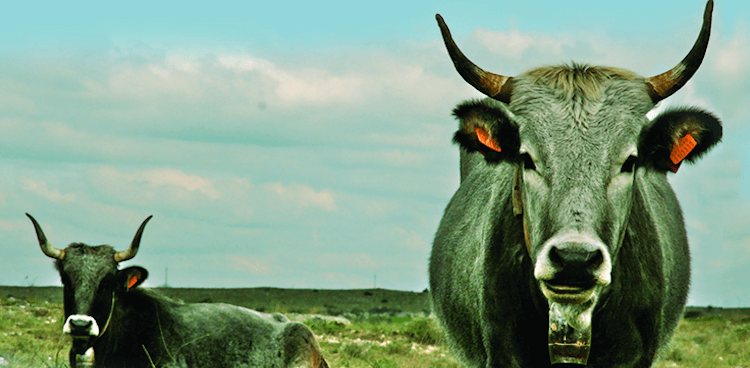
History
There are two theories about how the rare breed of Podolico cattle first came to Italy. One theory posits that the Podolicos arrived during the fourth century BCE by the Huns, who traveled from Mongolia to Italy and passed through what is modern-day Ukraine, where the cows were originally bred. The second possibility is that the cows were brought to Italy by the Romans from Crete, an area known for its large breeds of cattle. Regardless of how it traversed centuries ago, the Podolico breed now resides primarily in southern Italy, where there are presently about 21,000 cows.
Grazing
The hearty Podolico cow has adapted well to the mountains of the Basilicata region of Italy. This elevated terrain, created by thousands of years of earthquakes and volcanoes, is a rocky, harsh environment, hot in summer and dry and cold in winter. These mountains, with their wild herbs and grasses, are a perfect location for farmers who practice transhumance, the movement of grazing animals from the lowlands in winter to the mountains in summer.
Appearance & Temperament
There is a great deal of variability in the appearance of Podolico cows. They can range from 850 pounds to 1,100 pounds, and adult bulls can weigh from 1,300 pounds to 1,800 pounds. In addition, the coloration of the cows can range from white to gray to almost black. In general these long-horned cattle have a delicate build with a straight back and slender legs. Podolico cows are known for their docile nature and excellent mothering skills.
Milk
Podolico cows are used principally for meat production and only partially for their milk. Because they are grazed primarily from May through October, their milk is only seasonally available, with the majority being produced in May. During the summer months the cows’ diet consists entirely of upland grasses and mountain plants such as nettles, blueberries, rose hips, hawthorn, cornelian cherries, juniper, and wild strawberries. The milk that results from this diet is high in fat, very aromatic, and highly valued for cheesemaking.
Cheese
The milk from Podolico cows is most commonly used to make the “straw-gold, cantaloupe melon-size” caciocavallo podolico cheese. This cheese has a smooth rind that thickens as the cheese matures. The cheese is aged for a minimum of three months but can be matured for up to one year, at which point its flavors are complex and intense, with savory vegetal notes of smoke, herbs, toast, and barnyard balanced by an intense fruitiness and lactic tang.



